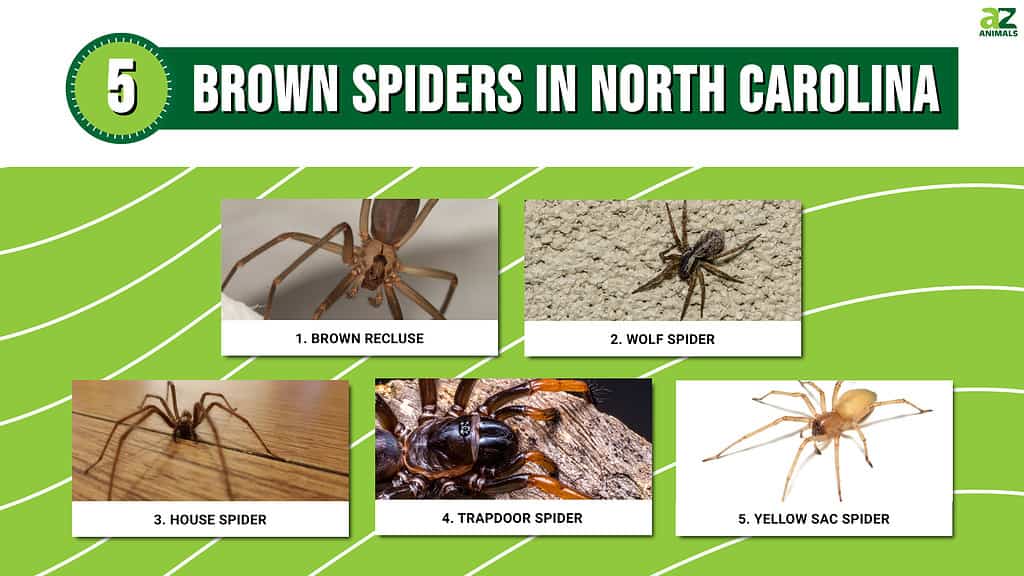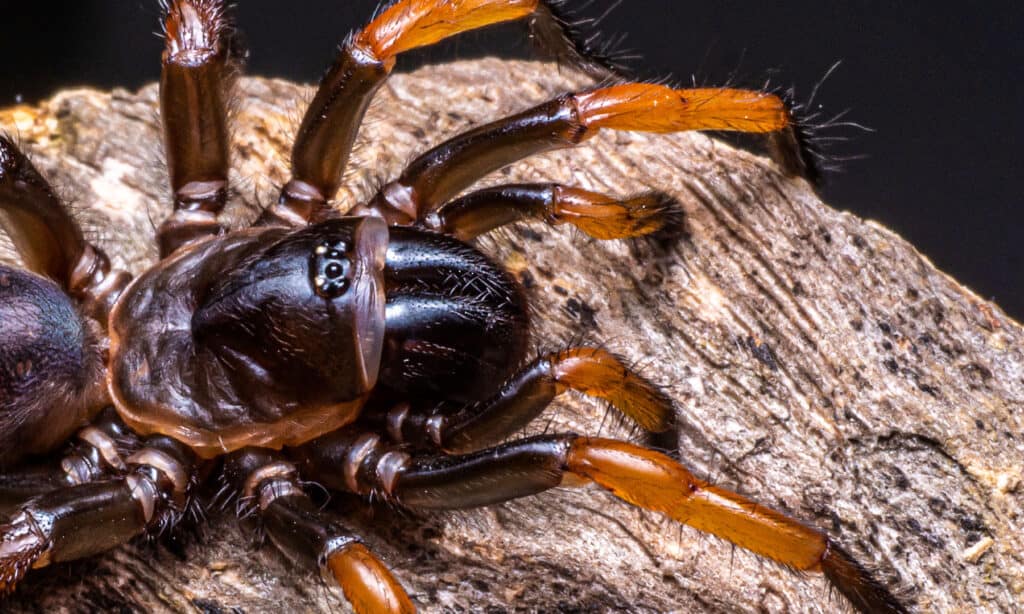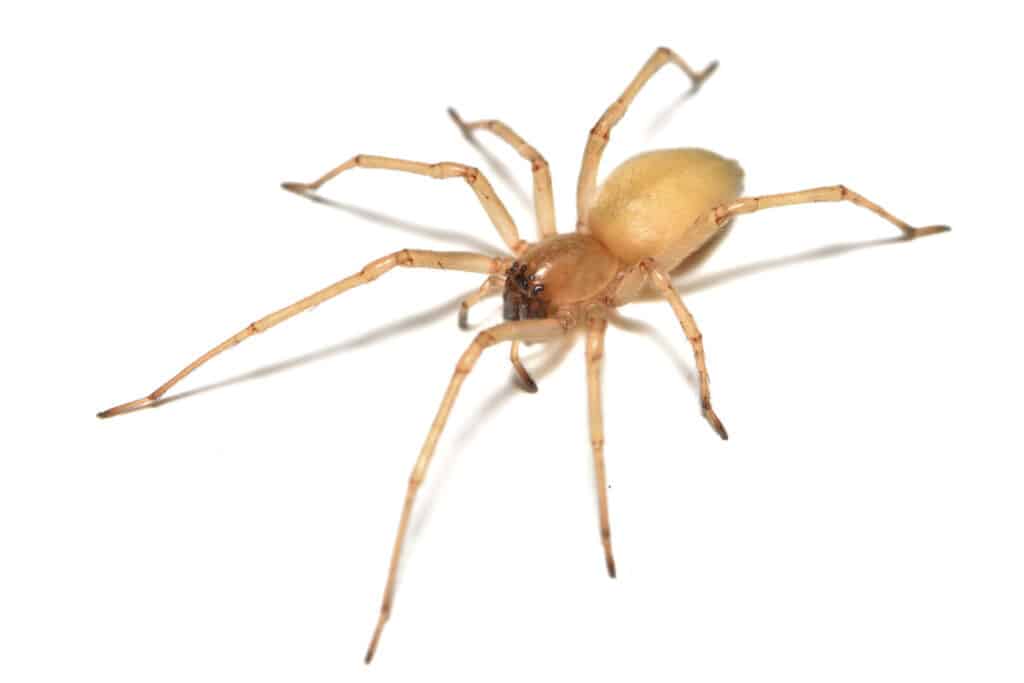In North Carolina, you can travel to the coast, head over to mountainous regions, or enjoy the central environment in bustling cities and quaint towns. But do you know about the brown spiders in North Carolina?
There’s a bit of everything in the state, including wildlife. Black bears, bobcats, white-tailed deer, and feral swine make up a few of the larger mammals.

There are plenty of birds to enjoy, particularly during migration when they fill the sky, commune in trees, and serenade residents with their cheerful songs. Closer to the ground are several reptiles, amphibians, and some creepy crawlies, including arachnids!
There are a variety of spiders strewn throughout the state living in different environments but in this article, we focus specifically on brown spiders!
5 Brown Spiders In North Carolina
1. Brown Recluse

The brown recluse spider is often identified by the violin-shaped marking on its body.
©Nick626/Shutterstock.com
Scientific Name: Loxosceles reclusa
Brown recluses are one of the most dangerous spider species in the state. These spiders are sneaky, hiding out in dark, shaded areas where they can enjoy dry environments. When found outdoors, they’re typically hidden within piles of wood or hanging out in a shed you seldom visit. Although they’re not native to the state, they have found their way in. These venomous spiders are also known as violin spiders or “fiddlebacks” because of the distinctive violin-shaped marking on their backs.
They grow as big as ½ inches long and their coloration ranges from tannish brown to dark brown. If a brown recluse manages to bite, symptoms may take a bit to notice. At first, there may be some itching and redness at the site of the bite.
A small sac filled with fluid may then develop along with some bruising. Additional symptoms of a brown recluse spider bite include nausea and vomiting, fever and chills, and aching muscles. These spider bites require medical attention to avoid skin necrosis.
2. Wolf Spider

Most wolf spiders do not make webs.
©Paul Reeves Photography/Shutterstock.com
Scientific Name: Lycosidae
The wolf spider is often mistaken for a brown recluse, but although it does share some similarities, it’s ultimately a lot bigger, growing up to 1.5 inches in length. Wolf spiders are also quite hairy, and because they can get so big, they’re often mistaken for tarantulas as well. Their coloration varies depending on the environment they’re in — they depend on their ability to camouflage for survival. Often, they’re black and brown.
What makes these spiders unique is the female carries her spiderlings on her back after carrying them in a sac at the tip of her abdomen. After they hatch, they all hop on board their mama’s back to hitch a ride with her wherever she goes for a few weeks.
These spiders are venomous, but they are not typically aggressive unless provoked. If a wolf spider bites you, symptoms may include itching, swelling, and pain that can be described as mild (unless you’re allergic, in which case medical attention may be required).
3. House Spider

They can be described as timid — if they feel threatened, they curl right up, relying on their camouflage and stillness to keep them protected.
©iStock.com/George Inguanez
Scientific Name: Parasteatoda tepidariorum
House spiders have different appearances and may be black, tan, and reddish. Some may also have yellowish markings. Their abdomens are kind of spotted and smeared with different colorations — there isn’t a single universal look to this spider species.
True to their name, they’re often found enjoying your porch or deck or hanging out on your windowsill. They weave disorganized webs, and they enjoy their privacy in these environments or in corners of rooms. They can be described as timid — if they feel threatened, they curl right up, relying on their camouflage and stillness to keep them protected.
4. Trapdoor Spider

The oldest spider ever was a female trapdoor spider. She lived to be 43 years old!
©nokkaew/Shutterstock.com
Scientific Name: Ctenizidae
Trapdoor spiders are dark brown, appearing almost black but some are more yellowish brown. They grow to just over one full inch in length and have an elusive nature. Incredibly, these spiders can live long lives, reaching up to 20 years of age. They live in burrows and construct little trap doors, hence their name. This door serves two purposes: it allows them to remain shielded from predators and shields them as they wait to trap their prey.
They’re a bit intimidating-looking, especially if you lean toward arachnophobia. However, these spiders have no interest in humans and only bite if they feel a need to defend themselves. They are certainly more inclined to seek after arthropods. Although venomous, their bites are more like the sting of a wasp, causing only minor symptoms like swelling and mild pain.
5. Yellow Sac Spider

The northern yellow sac spider builds a silk sac to hide from predators.
©Tobias Hauke/Shutterstock.com
Scientific Name: Cheiracanthium inclusum
Unlike other spiders in this list, the yellow sac spider is light-colored. It’s yellow and tan with the tips of their legs and their palps contrasting the rest of their bodies with a dark brown hue. The very first pair of their legs is the longest, and they need all eight for speed because they’re active hunters.
They don’t rely on the web as a prey-catching device. Instead, they use it as a place to nest and rest during the day. They eat both insects and spiders. These spiders are venomous and have bitten humans but only rarely. Their bites induce moderate pain along with itching.
Summary Of The 5 Brown Spiders In North Carolina
| Rank | Spider |
|---|---|
| 1 | Brown Recluse |
| 2 | Wolf Spider |
| 3 | House Spider |
| 4 | Trapdoor Spider |
| 5 | Yellow Sac Spider |
The photo featured at the top of this post is © nokkaew/Shutterstock.com
Thank you for reading! Have some feedback for us? Contact the AZ Animals editorial team.






